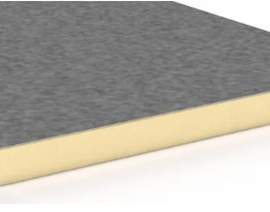PIR (Polyisocyanurate) BOARD INSULATION
What are the benefits of PIR Board Insulation?
- Offers very high R-value per thickness compared to other insulation types
- Low profile - Due to its high thermal resistance, PIR insulation allows you to achieve desired energy efficiency with thinner boards, making it ideal for projects where space is limited.
- Despite their rigidity, PIR boards are lightweight and easy to handle-
Where should you install PIR Board Insulation?
- Install in areas where maximum insulation value is needed with minimal thickness
- PIR boards can be used in a variety of applications, including walls, ceilings, roofs, and floors, making them a flexible choice for new builds and high-performance homes.
- Roofs
- Flat Roofs: PIR boards are an excellent choice for flat roof applications, providing a lightweight, durable solution with superior thermal performance.
-
Pitched Roofs: Installed between or over rafters, PIR boards help reduce heat transfer, keeping the home cooler in summer and warmer in winter.
- Walls
-
Exterior Walls: PIR boards are commonly used on Masonry walls or as external insulation in cladding systems, offering outstanding thermal performance without taking up too much space.
-
Internal Walls: They can also be installed on the inside of walls to improve insulation in renovations or extensions without significantly reducing internal room space.
How do you choose the right PIR Board Insulation?
- Determine the Application Area
-
Roof or Wall : PIR boards are versatile, but you need to select boards designed specifically for the application area, as thickness, size, and coatings may vary.
-
Internal or External Installation: Some PIR boards come with facings (e.g., foil) optimized for specific applications like cavity walls or external cladding.
2. Measure the Required Thickness
-
Meet R-Value Requirements: Check your local building code / consented plans for the minimum R-value needed in your project. PIR boards offer high R-values per thickness, allowing you to meet standards with thinner boards.
-
Space Constraints: If you’re working with limited space, choose a board that provides maximum thermal performance in a compact size.
3. Consider Facings or Coatings
-
Foil-Faced Boards: Ideal for enhancing thermal performance and acting as a vapor barrier in walls and roofs.
-
Paper or Glass-Fiber Facings: Suitable for applications requiring adhesion to other materials or where additional durability is needed.
-

-
Details
CNZ PIR
CNZ PIR Insulation Board 50mm R2.17
CNZ PIR Insulation Board 50mm Glass Fabric Faced R2.17 2.4m x 1.2m sheet - sold per sheet
NZ$210.00 -
-

-
Details
CNZ PIR
CNZ PIR Insulation Board 70mm R3.04
CNZ PIR Insulation Board 70mm Glass Fabric Faced R3.04 2.4m x 1.2m sheet - sold per sheet
NZ$230.00 -
-

-
Details
CNZ PIR
CNZ PIR Insulation Board 90mm R3.91
CNZ PIR Insulation Board 90mm Glass Fabric Faced R3.91 2.4m x 1.2m sheet - sold per sheet
NZ$270.00 -

